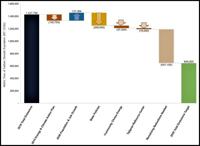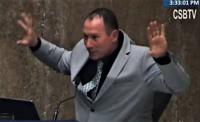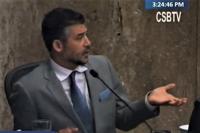The Santa Barbara County Board of Supervisors approved three next steps in tackling carbon emissions last week, although some expressed frustration over the amount of progress made so far under the Climate Action Plan.
On a 4-0 vote, with 5th District Supervisor Steve Lavagnino having to leave early, the board on April 5 approved developing an ordinance to restrict natural gas infrastructure and increase energy efficiency and electric vehicle charging infrastructure in new residential construction and major renovations.
The vote also directed staff to assess the feasibility of designing and constructing all county buildings to be all-electric and to replace or retrofit space and water heating equipment to electric in existing buildings.
The third step, as recommended by staff, calls for developing a Zero Emission Vehicle Plan to advance the use of zero-emission, or all-electric, vehicles in all county departments and the community.
Supervisors added that a previously approved requirement for the county to use electric sedans in its fleet should be expanded to departments that procure their own fleets and to include light-duty trucks and vans as of January 2023.
The vote on the next steps for the 2030 Climate Action Plan came following a final report on the 2015 Climate Action Plan that showed the county must still reduce its carbon dioxide equivalent emissions by 547,100 metric tons to reach the goal of 50% of its 2018 emissions.
Garrett Wong, the county’s climate program manager, said that 547,100 metric tons is equivalent to “117,862 passenger vehicles driving for one year.”
The hearing also involved a lengthy philosophical discussion over banning the use of natural gas in new homes and how much value the county is receiving from all its efforts to reach zero carbon emissions.
Fourth District Supervisor Bob Nelson didn’t like the idea of “running” to ban natural gas and said maybe the county should “jog” in that direction instead. He also said he wanted to make sure the impacts of such a ban were thoroughly studied and discussed in public hearings.
He later clarified he isn’t being an obstructionist but thought the county should focus on transportation, as that makes up 49% of the county’s emissions.
Lavagnino in particular expressed frustration over the progress the county has made in its efforts to reduce carbon emissions.
“What are we getting out of all this stuff?” he asked. “And, unfortunately, I was shocked at how ineffective we’ve been. I mean, there’s been so much activity with the Climate Action Plan, and workshops and presentations and community engagement presentations, and everybody’s just been pulling on the same end of the rope.”
He pointed to a chart in the staff report and said if the state mandates were taken out of the county’s total emission reductions, the decrease was 45,000 metric tons out of 1.4 million.
“Why aren’t we getting our bang for the buck?” he asked, pointing out the Tajiguas project to divert recyclables and compostables from the landfill cost $100 million. “I’m very discouraged. And we’re talking about banning natural gas. I mean, the payoff for that is another 10,000 metric tons.”
First District Supervisor Das Williams, who represents the county on the Central Coast Community Energy board, responded, “The reason why it’s harder to get ground is because the easy stuff is already in progress,” leaving only the hard stuff to do.
“As [Community Services Department Director George] Chapjian said, you know, these big things take a long time to turn around, and the fact that we’re not growing in greenhouse gas emissions is good,” 2nd District Supervisor Gregg Hart said.
“But I don’t want to be a Pollyanna about it, but we do need to have more aggressive goals and we need to do it faster at every level of government,” Hart said. “But we do have some things to talk about that are successful, and we should be proud of those, too.”




















